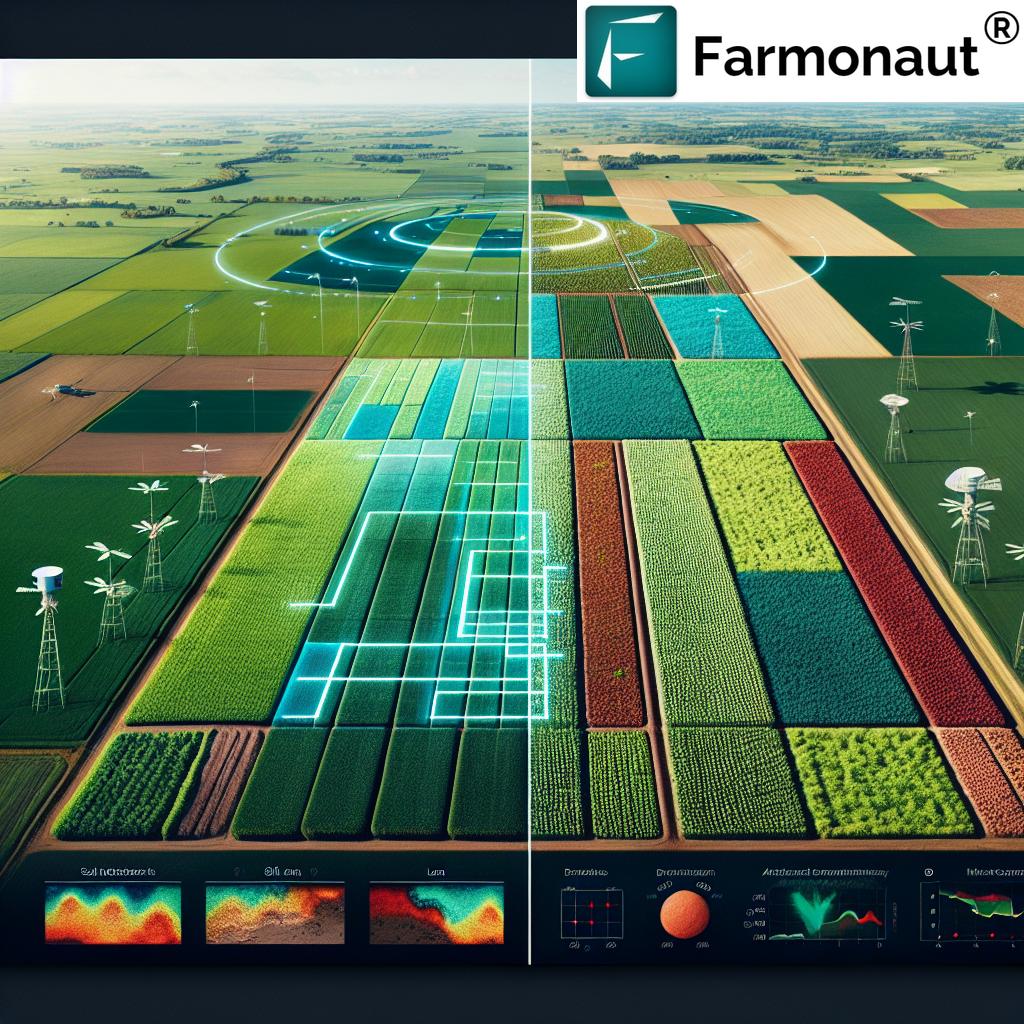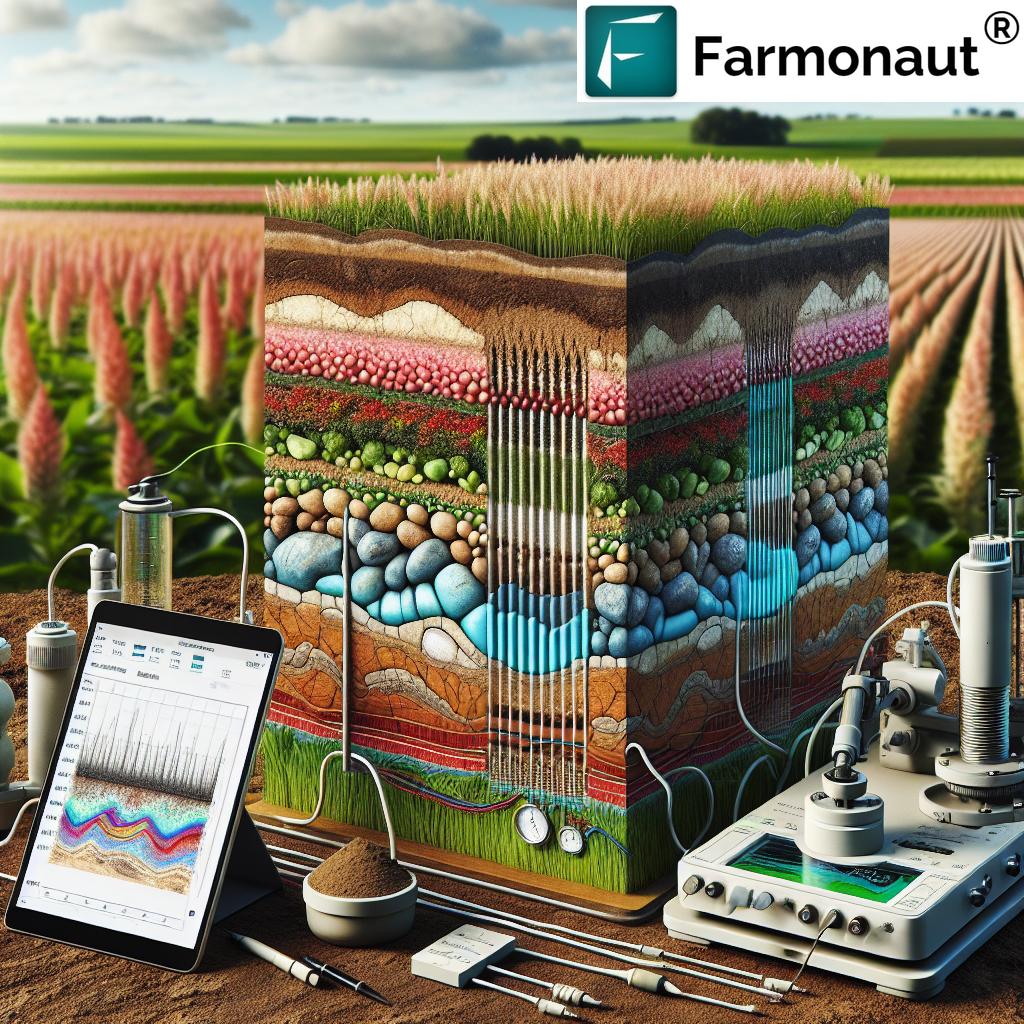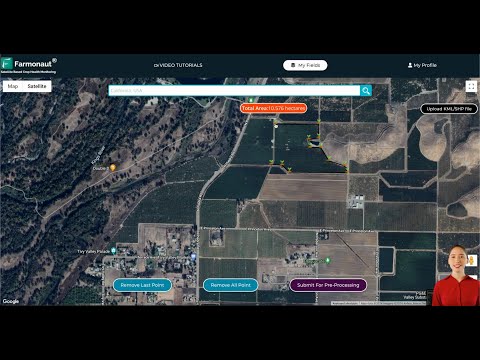Revolutionizing Illinois Agriculture: Precision Soil Analysis for Sustainable Farming and Optimal Crop Yields
“Illinois farmers using precision soil analysis techniques can improve crop yields by up to 20% while reducing fertilizer use by 15%.”
Welcome to the future of agriculture in Illinois! At Farmonaut, we’re at the forefront of revolutionizing farming practices through cutting-edge precision soil analysis and sustainable agricultural techniques. In this comprehensive guide, we’ll delve into the intricate world of soil composition, exploring how understanding the nuances of silt, loam, and clay can transform your farming operations and optimize crop yields.
As we navigate the complexities of modern agriculture, it’s crucial to embrace innovative technologies that allow us to make data-driven decisions. Our focus on precision farming techniques, coupled with advanced remote sensing and GIS technologies, empowers farmers to unlock the full potential of their land while promoting sustainable practices.

Understanding Soil Composition: The Foundation of Successful Farming
Soil composition is the bedrock of agricultural success. In Illinois, we encounter a diverse range of soil types, each with its unique characteristics and implications for farming. Let’s break down the primary soil components and their significance:
- Silt: Fine particles that provide excellent water retention and nutrient-holding capacity.
- Loam: A balanced mixture of sand, silt, and clay, often considered ideal for most crops.
- Clay: Tiny particles that can hold nutrients well but may have drainage issues.
- Sand: Larger particles that allow for good drainage but may struggle with nutrient retention.
Understanding these components is crucial for implementing effective agricultural land management strategies. At Farmonaut, our advanced soil composition analysis tools provide farmers with detailed insights into their soil’s makeup, enabling them to make informed decisions about crop selection, irrigation, and fertilization.
Precision Farming Techniques: Leveraging Technology for Optimal Results
Precision farming is at the heart of modern agriculture, and it’s revolutionizing how we approach crop cultivation. By utilizing advanced technologies, we can tailor our farming practices to the specific needs of each field, maximizing efficiency and yield while minimizing environmental impact.
Here are some key precision farming techniques we employ:
- Satellite-based crop monitoring: Our state-of-the-art satellite imagery provides real-time data on crop health, allowing for timely interventions.
- Soil moisture sensors: These devices help optimize irrigation by providing accurate soil moisture data.
- Variable rate technology (VRT): This allows for precise application of inputs based on soil and crop needs.
- GPS-guided machinery: Ensures accurate planting, spraying, and harvesting, reducing overlap and waste.
By implementing these precision farming techniques, Illinois farmers can significantly improve their crop yield optimization efforts while adhering to sustainable agriculture practices.
Sustainable Agriculture Practices: Nurturing the Land for Future Generations
At Farmonaut, we believe that sustainable agriculture is not just a buzzword but a necessity for the future of farming. Our approach focuses on maintaining soil health, conserving resources, and minimizing environmental impact while ensuring profitable crop production.
Key sustainable practices we promote include:
- Cover cropping: Planting cover crops between harvests to improve soil structure and prevent erosion.
- Crop rotation: Alternating crops to maintain soil fertility and break pest cycles.
- Conservation tillage: Reducing soil disturbance to preserve soil structure and organic matter.
- Integrated pest management (IPM): Using a combination of biological, cultural, and chemical methods to control pests effectively.
These practices not only contribute to long-term soil health but also play a crucial role in crop yield optimization. By nurturing the land, we ensure its productivity for years to come.
“Remote sensing technology in agriculture can detect soil moisture variations within 1% accuracy across 1000+ acre farms.”
Remote Sensing in Agriculture: A Game-Changer for Farm Management
Remote sensing technology has revolutionized the way we monitor and manage agricultural land. At Farmonaut, we harness the power of satellite imagery and advanced sensors to provide farmers with unprecedented insights into their fields.
Benefits of remote sensing in agriculture include:
- Early detection of crop stress: Identify issues before they become visible to the naked eye.
- Precise crop yield estimation: Make informed decisions about harvest timing and marketing.
- Soil moisture monitoring: Optimize irrigation schedules based on accurate soil moisture data.
- Nutrient deficiency detection: Target fertilizer application to areas that need it most.
Our remote sensing capabilities allow farmers to make data-driven decisions, leading to improved resource management and increased profitability.

GIS for Farm Planning: Mapping the Path to Success
Geographic Information Systems (GIS) have become an indispensable tool in modern farm planning. At Farmonaut, we integrate GIS technology with our precision farming solutions to provide comprehensive farm management capabilities.
Key applications of GIS in farm planning include:
- Field mapping: Create detailed maps of farm layouts, including field boundaries and topography.
- Yield mapping: Visualize crop yield variations across fields to identify areas for improvement.
- Resource allocation: Optimize the distribution of resources based on spatial data.
- Precision agriculture planning: Develop zone-specific management strategies for targeted interventions.
By leveraging GIS technology, Illinois farmers can make more informed decisions about land use, crop rotation, and resource allocation, ultimately leading to increased efficiency and profitability.
Soil Health Indicators: The Vital Signs of Your Farm
Monitoring soil health is crucial for maintaining productive farmland and implementing effective conservation strategies. At Farmonaut, we focus on key soil health indicators to provide a comprehensive picture of your soil’s condition.
Important soil health indicators include:
- Organic matter content: A key indicator of soil fertility and structure.
- pH levels: Affects nutrient availability and microbial activity.
- Soil structure and aggregation: Influences water retention and root growth.
- Microbial activity: Indicates the soil’s ability to cycle nutrients and suppress diseases.
- Water infiltration and retention: Crucial for efficient water use and erosion prevention.
By regularly assessing these indicators, farmers can take proactive measures to maintain and improve soil health, ensuring long-term productivity and sustainability.
Navigating Illinois’ Diverse Soil Landscape
Illinois boasts a rich tapestry of soil types, each presenting unique challenges and opportunities for agriculture. From the fertile prairies to the alluvial plains, understanding the specific characteristics of your soil is key to successful farming.
Common soil types in Illinois include:
- Mollisols: Deep, dark soils rich in organic matter, ideal for corn and soybean production.
- Alfisols: Well-developed soils with a clay-enriched subsoil, suitable for a variety of crops.
- Entisols: Young soils often found along rivers, requiring careful management for optimal productivity.
- Inceptisols: Moderately developed soils that can be highly productive with proper management.
At Farmonaut, our advanced soil analysis tools help farmers identify and understand their specific soil types, enabling them to tailor their management practices accordingly.
| Soil Type | Typical Composition (%) | Water Retention Capacity | Nutrient Holding Ability | Ideal Crops | Estimated Yield Potential (tons/acre) | Recommended Management Practices |
|---|---|---|---|---|---|---|
| Silty Loam | Silt: 50-80 Sand: 0-50 Clay: 0-27 |
High | Good | Corn, Soybeans, Wheat | Corn: 180-220 Soybeans: 60-80 |
Conservation tillage, Cover cropping |
| Clay Loam | Clay: 27-40 Silt: 15-52 Sand: 20-45 |
Very High | Excellent | Rice, Cotton, Sorghum | Rice: 7-9 Cotton: 2-3 (bales) |
Improved drainage, Deep tillage |
| Sandy Loam | Sand: 43-80 Silt: 0-50 Clay: 0-20 |
Low to Moderate | Poor to Moderate | Potatoes, Peanuts, Vegetables | Potatoes: 15-25 Peanuts: 2-4 |
Frequent irrigation, Organic matter addition |
| Peaty Soil | Organic matter: >20 Mineral content: <80 |
Very High | Variable | Specialty crops, Berries | Blueberries: 5-8 Cranberries: 150-250 (barrels/acre) |
pH management, Careful water management |
Subsoil Characteristics: The Hidden Influence on Crop Performance
While surface soil often gets the most attention, the characteristics of the subsoil play a crucial role in crop performance. At Farmonaut, we emphasize the importance of understanding subsoil properties for comprehensive farm management.
Key subsoil characteristics to consider include:
- Texture and structure: Affects water movement and root penetration.
- Compaction layers: Can restrict root growth and water infiltration.
- Nutrient profiles: Subsoil nutrient levels can significantly impact crop nutrition.
- pH and salinity: Influences nutrient availability and root development at deeper levels.
Our advanced soil analysis techniques provide insights into subsoil characteristics, enabling farmers to address issues such as compaction or nutrient deficiencies that may not be apparent from surface observations alone.
Soil Moisture Monitoring: The Key to Efficient Water Management
Effective water management is crucial for optimal crop growth and resource conservation. At Farmonaut, we provide cutting-edge soil moisture monitoring solutions that enable precise irrigation decisions.
Benefits of our soil moisture monitoring system include:
- Real-time data: Continuous monitoring allows for timely irrigation adjustments.
- Depth-specific measurements: Understand water distribution throughout the soil profile.
- Integration with weather forecasts: Optimize irrigation schedules based on predicted rainfall.
- Water use efficiency: Reduce water waste and associated costs.
By leveraging our soil moisture monitoring technology, Illinois farmers can ensure their crops receive the right amount of water at the right time, maximizing yields while conserving this precious resource.
Agricultural Data Analytics: Turning Information into Action
In the era of big data, agricultural data analytics has become a powerful tool for farm management. At Farmonaut, we harness the power of advanced analytics to transform raw data into actionable insights.
Our agricultural data analytics capabilities include:
- Yield prediction models: Forecast crop yields based on historical data and current conditions.
- Risk assessment tools: Identify potential threats to crop health and productivity.
- Resource optimization algorithms: Determine the most efficient use of inputs like water and fertilizer.
- Market trend analysis: Make informed decisions about crop selection and timing based on market data.
By leveraging these analytical tools, Illinois farmers can make data-driven decisions that improve efficiency, reduce risks, and maximize profitability.
Explore our API for advanced agricultural data analytics: Farmonaut API
For developers, check out our comprehensive API documentation: API Developer Docs
Navigating Challenging Soil Variants in Illinois
Illinois agriculture faces various soil-related challenges, from alluvial deposits to karst landscapes. At Farmonaut, we provide tailored solutions to help farmers overcome these unique soil conditions.
Some challenging soil variants in Illinois include:
- Alluvial soils: Young, variable soils along rivers that require careful management.
- Karst landscapes: Areas with limestone bedrock prone to sinkholes and rapid water drainage.
- Claypan soils: Soils with a dense, clay-rich subsoil layer that can impede drainage.
- Acid soils: Low pH soils that may require liming for optimal nutrient availability.
Our precision farming techniques and soil analysis tools help farmers identify and address these challenges, ensuring optimal crop performance even in difficult soil conditions.
Implementing Effective Conservation Strategies
Conservation is a crucial aspect of sustainable agriculture. At Farmonaut, we emphasize the importance of implementing effective conservation strategies to protect soil health and environmental resources.
Key conservation strategies we promote include:
- Contour farming: Planting across slopes to reduce erosion and improve water retention.
- Buffer strips: Planting grass or trees along waterways to filter runoff and protect water quality.
- Reduced tillage: Minimizing soil disturbance to preserve soil structure and organic matter.
- Precision nutrient management: Applying fertilizers based on specific soil and crop needs to reduce excess runoff.
By implementing these conservation strategies, Illinois farmers can protect their land’s long-term productivity while contributing to broader environmental sustainability goals.
The Future of Illinois Agriculture: Embracing Innovation
As we look to the future, the role of technology in agriculture will only continue to grow. At Farmonaut, we’re committed to staying at the forefront of agricultural innovation, providing Illinois farmers with the tools they need to thrive in an ever-evolving industry.
Emerging trends we’re exploring include:
- AI-driven crop management: Using artificial intelligence to optimize every aspect of crop production.
- Blockchain for traceability: Ensuring transparency and security in agricultural supply chains.
- Drone technology: Enhancing precision in field monitoring and targeted interventions.
- Climate-smart agriculture: Developing resilient farming practices in the face of climate change.
By embracing these innovations, Illinois farmers can position themselves at the forefront of agricultural productivity and sustainability.
Conclusion: Empowering Illinois Farmers for a Sustainable Future
The future of Illinois agriculture is bright, fueled by advances in precision farming, soil analysis, and sustainable practices. At Farmonaut, we’re proud to be part of this agricultural revolution, providing farmers with the tools and knowledge they need to maximize their land’s potential while preserving it for future generations.
From understanding the intricacies of soil composition to leveraging cutting-edge remote sensing technology, the path to optimal crop yields and sustainable farming is clear. By embracing these innovative approaches, Illinois farmers can not only improve their productivity and profitability but also contribute to a more sustainable and resilient agricultural sector.
We invite you to join us on this journey of agricultural transformation. Explore our range of services and see how Farmonaut can help revolutionize your farming operations:
Frequently Asked Questions (FAQ)
Q: How can precision soil analysis improve my farm’s productivity?
A: Precision soil analysis provides detailed insights into your soil’s composition, nutrient levels, and health indicators. This information allows you to make targeted decisions about fertilization, irrigation, and crop selection, leading to optimized yields and resource efficiency.
Q: What types of crops benefit most from Farmonaut’s technology?
A: Our technology benefits a wide range of crops, including corn, soybeans, wheat, and specialty crops. The satellite-based monitoring and precision farming techniques are adaptable to various agricultural systems.
Q: How often should I conduct soil analysis on my farm?
A: We recommend conducting comprehensive soil analysis every 3-5 years. However, more frequent monitoring of key parameters like pH and nutrient levels can be beneficial, especially in intensively managed systems.
Q: Can Farmonaut’s solutions help me reduce my environmental impact?
A: Yes, our precision farming techniques and sustainability-focused approaches help reduce environmental impact by optimizing resource use, minimizing chemical inputs, and promoting soil conservation practices.
Q: How does remote sensing technology work in agriculture?
A: Remote sensing uses satellite imagery and other aerial data to monitor crop health, soil moisture, and field conditions. This technology provides a comprehensive view of your farm, allowing for early detection of issues and informed decision-making.






